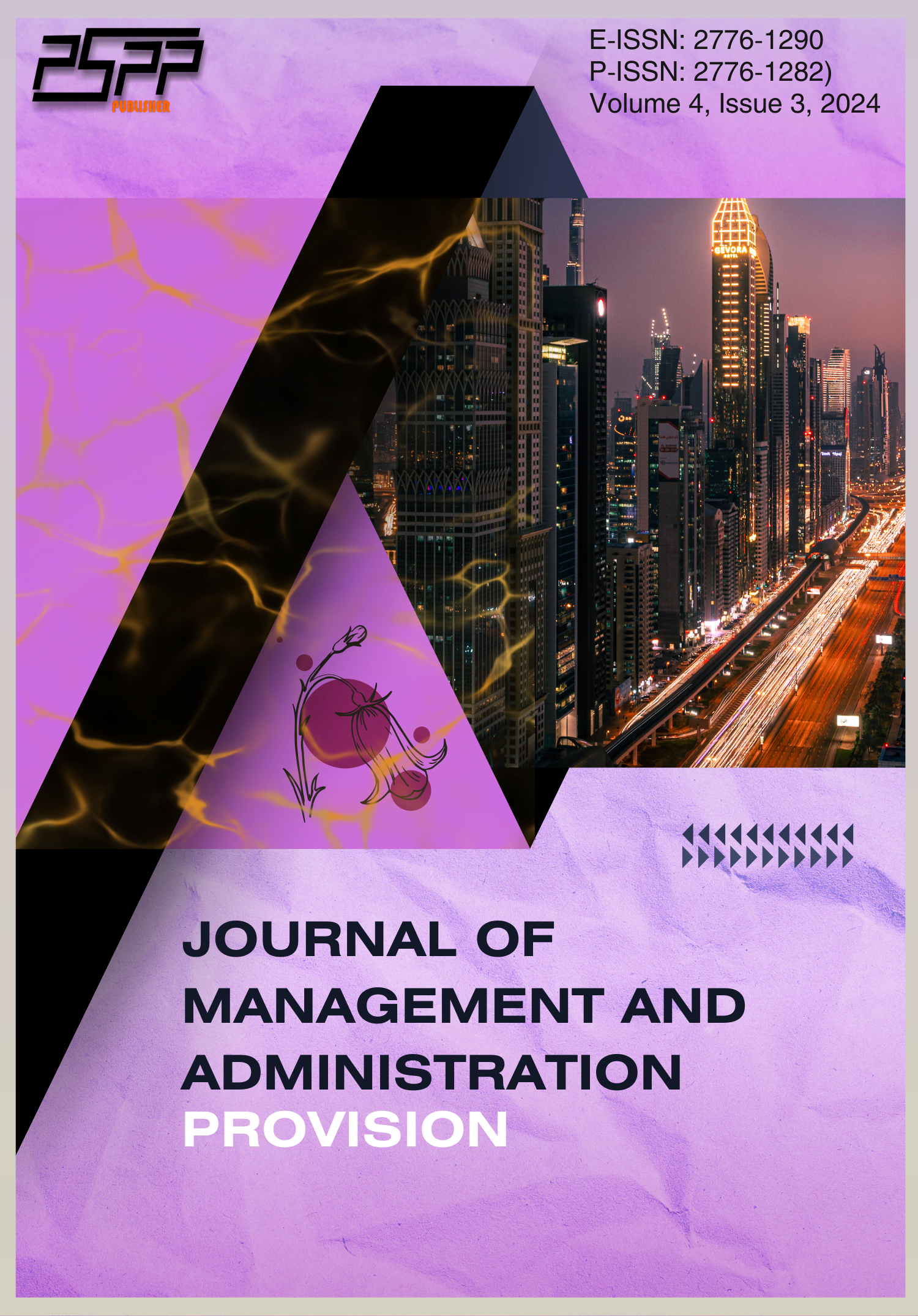Innovation of Public Service E-Court of Bojonegoro Religious Court: Study Case of Divorce Case
DOI:
https://doi.org/10.55885/jmap.v4i3.433Keywords:
Innovation, Public Service, E-CourtAbstract
This article aims to describe the innovation of the Bojonegoro Religious Court in resolving divorce cases to create good public services and to find out whether there are challenges in developing this e-court application innovation. The problem focuses on how effective e-court innovation is in improving the quality of public services, especially divorce handling and identifying obstacles and aspects that need to be improved so that it becomes a sustainable application in the future. In order to approach this problem, a theoretical reference from M. Roger is used, with 5 innovation attributes, namely: relative advantage, suitability, complexity, possibility of trying and ease of observation. Data was collected through a case study approach, interviews, observations, and analyzed qualitatively. This study concludes that in this modern era the government is required to create a service that can make things easier for society through the use of technology. One of the uses of technology made by the Supreme Court is e-court. E-Court is an electronic administration service that allows people to conduct matters online. This service aims to make it easier for people who are constrained by time and costs, as well as reaching areas farthest from the court. Several service features available in e-court include online case registration (E-Filling), electronic down payment estimates (E-Payment), online summons (E-Summons) and online trials (E-Litigation).References
Arifin, H., Sudirman, L., Rahmawati, R., Basri, R., & Fikri, F. (2024). Efektivitas Penerapan E-Court Perkara Perceraian di Pengadilan Agama Parepare. UNES Law Review, 6(3), 8490–8502. https://doi.org/10.31933/unesrev.v6i3.1726
Azzahiroh, M., Zamahsari, H. A., & Mahameru, Y. (2020). Implementasi Aplikasi E-Court Dalam Mewujudkan Pelayanan Publik Yang Baik Di Pengadilan Negeri Kota Malang. Jurnal Teknologi Dan Komunikasi Pemerintahan, 2(2), 58–74. https://doi.org/10.33701/jtkp.v2i2.2318
Badan Pusat Statistik. (2023). Jumlah Perceraian Menurut Provinsi Dan Faktor 2023. https://www.bps.go.id/id/statistics-table/3/YVdoU1IwVmlTM2h4YzFoV1psWkViRXhqTlZwRFVUMDkjMw==/jumlah-perceraian-menurut-provinsi-dan-faktor.html?year=2023
Beno, J., Silen, A., & Yanti, M. (2022). Penerapan Aplikasi E-Court di Pengadilan Agama Sungguminasa Kelas I B. Braz Dent J., 33(1), 1–12. https://doi.org/10.24252/al-qadau.v9i1.27156
Bojonegoro, S. (2024). Banyaknya Kasus Cerai Gugat, Kemenag Bojonegoro Nyatakan Angka Nikah semakin Turun tahun 2024. https://suarabojonegoro.com/banyaknya-kasus-cerai-gugat-kemenag-bojonegoro-nyatakan-angka-nikah-semakin-turun-tahun-2024/
CNBC Indonesia. (2024). Cerai Akibat Judi Melonjak 142%, Paling Banyak di Jawa Timur. Cerai Akibat Judi Melonjak 142%25, Paling Banyak di Jawa Timur
Djatmiko, H. (2019). Implementasi Peradilan Elektronik (E-Court) Pasca Diundangkannya Perma Nomor 3 Tahun 2018 Tentang Administrasi Perkara Di Pengadilan Secara Elektronik. Legality, 01, 22–32. https://doi.org/10.47637/legalita.v1i1.28
Hidayat, W. (2017). Tangerang Live Di Kota. 48–57. http://tangerangkota.go.id/peresmian-tangerang-
Indonesia, M. A. R. (2022). Surat Keputusan Mahkamah Agung RI Nomor 363/KMA/SK/XII/2022 Tentang Petunjuk Teknis Administrasi dan Persidangan Perkara Perdata, Perdata Agama, dan Tata Usaha Negara di Pengadilan Secara Elektronik.
Indonesia. (2009). Undang-undang (UU) Nomor 25 Tahun 2009 tentang Pelayanan Publik. BPK RI: Jakarta.
Mahkamah Agung Republik Indonesia. (2019). Buku Panduan e-Court Mahkamah Agung 2019 : The Electronic Justice System. Mahkamah Agung Republik Indonesia, 1–84.
Mahkamah, A. R. I. (2022). Keputusan Ketua Mahkamah Agung Republik Indonesia. Mahkamah Agung, 4(1), 88–100. https://www.pta-bengkulu.go.id/images/pdf_trans_perkara/sk_kma_26_2012.pdf
Pebriyanto, D. Y., & Suprastiyo, A. (2023). Inovasi Pelayanan Publik E-Health Rumah Sakit Umum Daerah (Rsud) Sumberrejo Bojonegoro. JIAN-Jurnal Ilmu Administrasi Negara, 7(1), 27–32.
Ridlo, M. (2021). Sejarah Perkembangan Peradilan Agama pada Masa Kesultanan dan Penjajahan Sampai Kemerdekaan. Asy-Syari’ah: Jurnal Hukum Islam, 7(2), 152-167. https://doi.org/10.55210/assyariah.v7i2.612
Rogers, E. M., Difusi, B. U., & Everett, M. (2017). Diffusion Of Innovations. In Achieving Cultural Change in Networked Libraries. https://doi.org/10.4324/9781315263434-16
Ruslan, N. A., & Talli, A. H. (2021). Efektivitas Beracara Secara Elektronik Dalam Penyelesaian Perkara Perceraian Di Pengadilan Agama Parepare. Qadauna: Jurnal Ilmiah Mahasiswa Hukum Keluarga Islam, 2(3), 450–464. https://doi.org/10.24252/qadauna.v2i3.21488
Sachrudin, A., Peni, D., & Listyawati, R. (2020). The Views Of Religious Court Judges In Semarang On The Implementation Of E-Court In The Administration And Court Proceedin. 580–598.
Sari, N. P. R. K. (2019). Eksistensi E-Court Untuk Mewujudkan Asas Sederhana, Cepat, Dan Biaya Ringan Dalam Sistem Peradilan Perdata Di Indonesia. Yustitia, 13(1), 1–17. https://doi.org/10.62279/yustitia.v13i1.275
Septian, E. (2021). Penerapan Sistem Pelayanan Aplikasi Pendaftaran Online di Rumah Sakit Umum Pusat Dr. Sardjito Yogyakarta. Matra Pembaruan, 5(1), 53–64. https://doi.org/10.21787/mp.5.1.2021.53-64
Shodikin, A., Saepullah, A., & Lestari, I. I. (2021). Efektivitas Penerapan Sistem E-Court Pengadilan Agama Dalam Perkara Perceraian. Jurnal Mediasas : Media Ilmu Syari’ah Dan Ahwal Al-Syakhsiyyah, 4(2), 135. https://doi.org/10.58824/mediasas.v4i2.290
Sugiyono. (2019). Metode Penelitian Kuantitatif, Kualitatif, dan R&D. Alphabet.
Suyitno. (2018). Metode Penelitian Kualitatif: Konsep, Prinsip, dan Operasionalnya. In Akademia Pustaka.
Wahyudi, T. (2023). Angka Perceraian Tinggi di Bojonegoro, Politisi Go Tjong Ping Beber Penyebabnya. Pemerintah Provinsi Jawa Timur. Angka Perceraian Tinggi di Bojonegoro, Politisi Go Tjong Ping Beber Penyebabnya.
Downloads
Published
How to Cite
Issue
Section
License
Copyright (c) 2024 Journal of Management and Administration Provision

This work is licensed under a Creative Commons Attribution-ShareAlike 4.0 International License.
Licensing Statement
Journal of Management and Administration Provision operates under articles of this journal licensed under a https://creativecommons.org/licenses/by/4.0. This allows for the reproduction of articles, free of submissions charge, with the appropriate citation information. All authors publishing with the Journal of Management and Administration Provision accept these as the terms of publication.

















